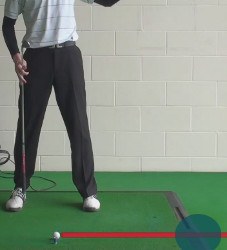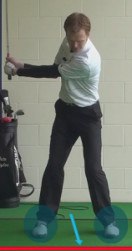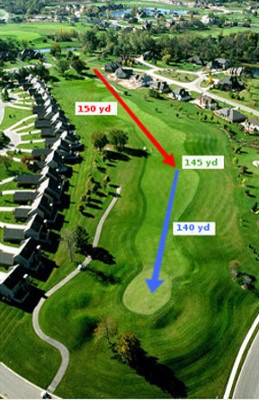
Many American golfers consider the blind shot – where you can't see the target you're hitting to – an abomination.
Most course designers avoid building holes with blind shots at all costs. Don't want to annoy the paying customers, after all.
But sometimes, blind shots come with the territory – especially if that territory is unusually hilly or studded with sand dunes. Blind shots are common on the courses of Great Britain, especially those ancient links where man had little hand in the layout.
Love them or loathe them, blind shots are part of the game. Here's how to conquer them, or at least survive to play the next hole:

- Many blind shots play uphill, so factor in the slope when calculating yardage. As a general rule, for each yard of slope the target sits above the level of your ball, add the same number of yards to your actual yardage. For example, if the target is 30 feet above you, add 10 yards.
- Choose an aiming point directly in line with the target. This may be a tree behind the green, or a spot on a dune that blocks your view.
- Line up with the spot and trust your alignment, even if it feels off.
- Hit and hope.
If you can't find your ball when arriving at the green, always check the hole!
In golf terminology, a 'blind' shot is one where you can't actually see the target from your address position.

The target is out of view from your position, meaning you won't be able to look up and confirm your aim before starting your swing. These kinds of shots are notoriously tricky, as they make even the most experienced players a little nervous. It is possible to produce quality shots when you find yourself in this predicament, but you'll need to have a plan.
This article is going to offer advice on how you can successfully handle blind golf shots when they come up. Depending on where you typically play your golf, you may deal with a few blind shots in every round – or you may go several rounds without facing a single one. It all depends on the elevation changes within the layout. Courses with dramatic elevation changes tend to have plenty of blind shots. Flat courses, on the other hand, will rarely present you with this situation.
The difficulty that many players have with blind shots is a little surprising considering the fact that you don't actually look at the target when hitting a golf shot. In a way, every shot is a 'blind' shot, since you should be looking at the ball while making your swing, rather than looking up early at the target. So, why are these shots so tough? It all comes down to comfort and confidence. When you can look up at the target from your address position before starting the swing, you can reassure yourself that you're lined up properly. Most players take a look up at the target, move their eyes back down to the ball, and start the swing. This rhythm is comforting, and it gives you a positive feeling before putting the club in motion.
On a blind shot, you don't have that kind of comfort. You can't see much of anything when you look up, so you're left to look back down to the ball and hope for the best. Confidence is incredibly important in golf, and it can be in short supply when you deal with a blind shot. One of our goals in this article is to help you find ways feel confident on these shots. If you can stand over the ball and believe in what you are doing, the odds of reaching a successful outcome are going to be greatly increased.
All of the content below is based on a right-handed golfer. If you happen to play left-handed, please take a moment to reverse the directions as necessary.
Types of Blind Shots

There are a number of different kinds of blind golf shots that you may encounter as you play this game. It is important to understand the various situations you may face, so you can be ready to deal with them successfully when they arise. The list below highlights a few of the common ways in which a golf shot can be made 'blind'.
- Severe elevation drop. If the target for your shot – either the fairway or the green – is significantly below where you are standing to hit the shot, there is a chance you won't actually be able to see the target. Of course, this won't always be the case, as your ability to see the target is going to be determined by the topography between your ball and the fairway or green. This is one of the trickiest blind shots to deal with, as it can feel like you are hitting your ball off into space with no firm target in mind. In addition to making sure you aim in the right direction, you'll also need to make sure the group in front of you has moved out of the way before you make a swing.
- Sharply uphill shot. On the other side of the coin, and uphill shot can be blind, although in a different way. If the ground slopes up dramatically toward the fairway or green, you won't be able to see the surface of the landing area. However, this is generally an easier situation than playing downhill, as you'll at least be able to see all of the ground between your ball and your target. So, while most amateur golfers think of downhill shots as being easier than uphill shots, that isn't always going to be the case. As long as you use enough club to cover the uphill distance, you might find that dealing with an uphill shot is preferable to a blind, downhill situation.
- Shot over trees. This isn't a situation which is going to come up frequently, but you do need to be aware of it as a possibility. Sometimes, specifically on approach shots, you may need to hit the ball over some trees toward your target. When that happens, you probably won't be able to get a good look at the green (or fairway, in a rare instance). The visual element of this kind of shot is one issue, as is the fact that you'll need to get sufficient air under the ball to clear the trees safely.
- Green guarded by a big bunker. Some golf course designers love to use this trick. On an otherwise plain and straightforward hole, the course designer may play a large bunker prominently in front of the green. If the bunker has a high lip, it may actually obscure your view of the green, bringing some doubt into the shot you are about to play. You'll need to find a way to pick an appropriate target line in this case, and you'll also want to use plenty of club to carry the sand. It should be mentioned that these kinds of bunkers aren't always placed immediately next to the green, so double check your yardage – and trust it – before hitting the shot. By setting the bunker maybe 20 or 30 yards short of the green, the course designer can sometimes trick the player into coming up short of the putting surface.
You won't need any help identifying a blind shot when you come upon one during your next round – if you can't see the target, it's a blind shot. However, it is still helpful to think about the various kinds of blind shots that are possible, as your approach may change from one situation to the next. It's one thing to learn how to deal with the blind shots on your home course, but it's another thing entirely to be able to handle these shots when playing another course for the first time.
When you do arrive at a blind shot, don't let yourself be intimidated. Most of the time, dealing with this shot successfully comes down to mind over matter. Rather than being put off by the uncomfortable visual of the shot, simply get down to work on identifying a target and making a great swing. Blind shots tend not to be as difficult as they seem at first, as long as you take the time necessary to develop a smart plan.
A Simple Strategy

In this section, we are going to get down to work on creating a basic strategy that you can use on most of your blind shots. Once you are comfortable with this strategy, you'll be surprised at how beneficial it can be on the course. In fact, you may like it so much that you find yourself using it in some situations where you can see the target.
So, how does it work? To get started, you are going to figure out where you are trying to hit the ball. That might seem like an obvious starting point, but many amateurs never even get that far. If you are playing a downhill blind shot, you may need to walk up the fairway a bit to get a view (or drive the cart up). On an uphill shot, you should be able to see most of what you need to see, but you'll want to think carefully about where to position the ball. Don't proceed beyond this first step until you are completely convinced that you have the right target area in mind.
Once you know where you would like the ball to end up, your next task is to pick an alternative target that you can actually see from your address position. This is an object that is directly on your intended target line, but it is not the target itself (since you can't see the target from where you are standing to hit the shot). One common example of this concept is using a tree off in the distance for your aiming point. If there are trees behind the green, pick out one that is on your intended line and use it when you are getting lined up. Assuming you can see at least part of the tree from where you are standing, it should serve as a perfect alignment aid.
Of course, not all golf courses are lined with trees. If there are no trees around the course you are playing, or if there are no trees in the right position to serve as a target, you'll have to get more creative. In this kind of situation, you may want to look closer to your ball. Specifically, look for old divots or other marks on the fairway that stand out from the rest of the green grass. Even the nicest courses have plenty of marks in the fairway, you just have to look closely. Stand behind your ball, picture the line you want to use, and pick out something that can serve as an intermediate target. Then, when you step up to take your stance, you can use that intermediate point for aiming purposes, rather than looking off into the distance (and not seeing anything useful).
The concept here is simple – you are going to replace the actual target with a target that you can see from your address position. If you do this successfully, you should be able to make your swing with much more confidence, knowing that you are aimed in the right direction. This technique may not make blind shots easy, but they will be far less intimidating.






